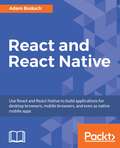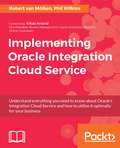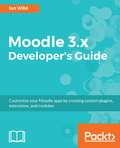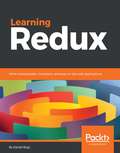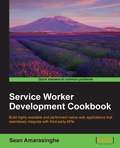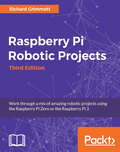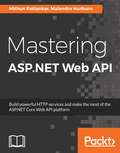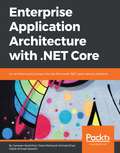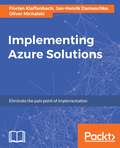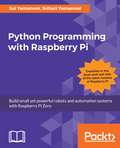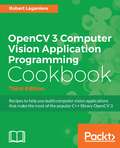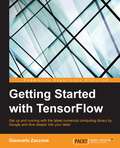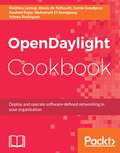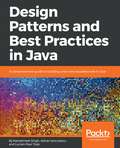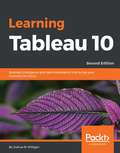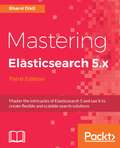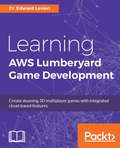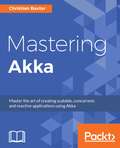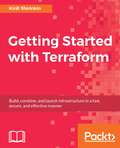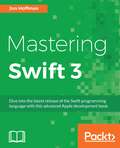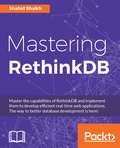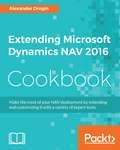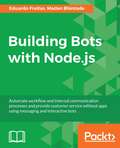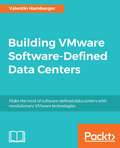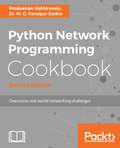- Table View
- List View
React and React Native
by Adam BoduchUse React and React Native to build applications for desktop browsers, mobile browsers, and even as native mobile apps About This Book • Build React and React Native applications using familiar component concepts • Dive deep into each platform, from routing in React to creating native mobile applications that can run offline • Use Facebook's Relay, React and GraphQL technologies, to create a unified architecture that powers both web and native applications Who This Book Is For This book is written for any JavaScript developer—beginner or expert—who wants to start learning how to put both of Facebook's UI libraries to work. No knowledge of React is needed, though a working knowledge of ES2015 will help you follow along better. What You Will Learn • Craft reusable React components • Control navigation using the React Router to help keep your UI in sync with URLs • Build isomorphic web applications using Node.js • Use the Flexbox layout model to create responsive mobile designs • Leverage the native APIs of Android and iOS to build engaging applications with React Native • Respond to gestures in a way that's intuitive for the user • Use Relay to build a unified data architecture for your React UIs In Detail React and React Native allow you to build cross-platform desktop and mobile applications using Facebook's innovative UI libraries. Combined with the Flux data architecture and Relay, you can now create powerful and feature-complete applications from just one code base! This book is split into three parts. The first part shows you how to start crafting composable UIs using React, from rendering with JSX and creating reusable components through to routing and creating isomorphic applications that run on Node. We then move on to showing you how to take the concepts of React and apply them to building Native UIs using React Native. You'll find out how to build responsive and streamlined UIs that can properly handle user interactions in a mobile environment. You'll also learn how to access device-specific APIs such as the geolocation API, and how to handle offline development with React Native. Finally, we'll tie all of these skills together and shows you how you can create React applications that run on every major platform. As well as understanding application state in depth, you'll learn how to leverage Relay to make feature-complete, data-driven web and native mobile applications. Style and approach Split into three major sections to help organize your learning, this hands-on, code-first book will help you get up to speed with React and React Native—the UI framework that powers Netflix, Yahoo, and Facebook.
Implementing Oracle Integration Cloud Service
by Phil Wilkins Robert Van MolkenUnderstand everything you need to know about Oracle's Integration Cloud Service and how to utilize it optimally for your business About This Book • The only guide to Integration Cloud Service in the market • Focused on practical action to deliver business value • A professional's guide to an expensive product, providing comprehensive training, and showing how to extract real business value from the product Who This Book Is For This book is ideal for any IT professional working with ICS, any Oracle application or cloud solution developer or analyst who wants to work with ICS to deliver business value. What You Will Learn • Use ICS to integrate different systems together without needing to be a developer • Gain understanding of what a number of technologies and standards provide – without needing to understand the fine details of those standards and technologies • Understand the use of connectors that Oracle provide from technology based connections such as file and database connections to SaaS solutions ranging from Salesforce to Twitter • Enrich data and extend SaaS integration to route to different instances • Utilize a number of tools to help develop and check that your integrations work before connecting to live systems • Introduce and explain integration concepts so that the integrations created are maintainable and sustainable for the longer term • Provide details on how to keep up to date with the features that Oracle and partners provide in the future • Get special connections developed to work with ICS In Detail Businesses are built on data, and applications that access that data. In modern businesses the same cloud-based data stores and applications might be accessed by hundreds of different applications from thousands of different devices via APIs. To make this happen, APIs must be wired together i.e. integrated. Oracle Integration Cloud Service provides a complete method for integrating enterprise applications in the cloud. Integration Cloud Service (ICS) provides a cloud hosted means to integrate systems together using a graphical means to define and represent integrations. This book will be a comprehensive, hands-on guide to building successful, high-availability integrations on ICS. This book sets out to demonstrate how ICS can be used to effectively implement integrations that work both in the cloud and on premise. It starts with a fast, practical introduction to what ICS can do for your business and then shows how ICS allows you to develop integrations not only quickly but in a way that means they are maintainable and extensible. Gradually it moves into more advanced integrations, showing how to achieve sophisticated results with ICS and work with external applications. Finally the book shows you how to monitor cloud apps and go beyond ICS to build even more powerful integrated applications. By the end of the book, you will the knowledge on how to use ICS to solve your own integration needs and harness the technologies in a maintainable and sustainable manner. Style and approach This book will take a pragmatic approach and will be a business-focused guide to delivering business value with ICS.
Moodle 3.x Developer's Guide
by Ian WildEffortlessly ensure your application's code quality from day 1 About This Book • Customize your Moodle 3.x app. • Leverage the new features of Moodle 3.x by diving deep into the Moodle development eco-system. • Cater to heavy user traffic, customize learning requirements and create custom third party plugins. Who This Book Is For This book is for Moodle developers who are familiar with the basic Moodle functionality and have an understanding of the types of scenarios in which the Moodle platform can be usefully employed. You must have medium-level PHP programming knowledge. You should be familiar with HTML and XML protocols. You do not need to have prior knowledge of Moodle-specific terminology What You Will Learn • Work with the different types of custom modules that can be written for Moodle 3.x • Understand how to author custom modules so they conform to the agreed Moodle 3.x development guidelines • Get familiar with the Moodle 3.x architecture—its internal and external APIs • Customize Moodle 3.x so it can integrate seamlessly with third-party applications of any kind • Build a new course format to specify the layout of a course • Implement third-party graphics libraries in your plugins • Build plugins that can be themed easily • Provide custom APIs that will provide the means to automate Moodle 3 in real time In Detail The new and revamped Moodle is the top choice for developers to create cutting edge e-learning apps that cater to different user's segments and are visually appealing as well. This book explains how the Moodle 3.x platform provides a framework that allows developers to create a customized e-learning solution. It begins with an exploration of the different types of plugin.. We then continue with an investigation of creating new courses. You will create a custom plugin that pulls in resources from a third-party repository. Then you'll learn how users can be assigned to courses and granted the necessary permissions. Furthermore, you will develop a custom user home. At the end of the book, we'll discuss the Web Services API to fully automate Moodle 3.x in real time. Style and approach This book takes a step-by-step practical approach with every step explained in great detail using practical examples. You will create custom plugins from scratch with the examples shown and create new modules as well as extensions with the examples presented.
Learning Redux
by Daniel BuglBuild consistent web apps with Redux by easily centralizing the state of your application. About This Book • Write applications that behave consistently, run in different environments (client, server and native), and are easy to test • Take your web apps to the next level by combining the power of Redux with other frameworks such as React and Angular • Uncover the best practices and hidden features of Redux to build applications that are powerful, consistent, and maintainable Who This Book Is For This book targets developers who are already fluent in JavaScript but want to extend their web development skills to develop and maintain bigger applications. What You Will Learn • Understand why and how Redux works • Implement the basic elements of Redux • Use Redux in combination with React/Angular to develop a web application • Debug a Redux application • Interface with external APIs with Redux • Implement user authentication with Redux • Write tests for all elements of a Redux application • Implement simple and more advanced routing with Redux • Learn about server-side rendering with Redux and React • Create higher-order reducers for Redux • Extend the Redux store via middleware In Detail The book starts with a short introduction to the principles and the ecosystem of Redux, then moves on to show how to implement the basic elements of Redux and put them together. Afterward, you are going to learn how to integrate Redux with other frameworks, such as React and Angular. Along the way, you are going to develop a blog application. To practice developing growing applications with Redux, we are going to start from nothing and keep adding features to our application throughout the book. You are going to learn how to integrate and use Redux DevTools to debug applications, and access external APIs with Redux. You are also going to get acquainted with writing tests for all elements of a Redux application. Furthermore, we are going to cover important concepts in web development, such as routing, user authentication, and communication with a backend server After explaining how to use Redux and how powerful its ecosystem can be, the book teaches you how to make your own abstractions on top of Redux, such as higher-order reducers and middleware. By the end of the book, you are going to be able to develop and maintain Redux applications with ease. In addition to learning about Redux, you are going be familiar with its ecosystem, and learn a lot about JavaScript itself, including best practices and patterns. Style and approach This practical guide will teach you how to develop a complex, data-intensive application leveraging the capabilities of the Redux framework.
Service Worker Development Cookbook
by Sean AmarasingheBuild highly available and performant native web applications that seamlessly integrate with third-party APIs About This Book * Get straight into the action with step-by-step recipes that show you how to put Service Workers to work * Find out what Service Workers can do for your app, then do it! * Get the first in-depth look at this important new feature for web developers Who This Book Is For Web developers, mobile application developers, and software engineers with any level of knowledge can use this book. You should be familiar with JavaScript and HTML. What You Will Learn * Display a custom offline page * Cache critical resources for offline use * Implement offline Google Analytics * Get network responses offline * Implement push notifications * Improve performance of your app In Detail It would be nice to have web apps that work offline and send push notifications. This is now possible with Service Workers, which can add native-like functionality to your web apps without requiring a download. This book will get your mobile and web apps functioning without Internet connectivity, improve performance and network interaction in order to increase the level of availability, and show you how to build performant applications that seamlessly integrate with third-party APIs. We'll show you how to add Service Worker functionality to web apps and sites, access offline content through basic and advanced techniques, and build powerful interactive system notifications. We'll also teach you about cache functionality and assets to provide immediate load even over narrow connections. We conclude by giving you various tips to improve app performance, including the background sync technique. By the end of this book, you'll know build high performing and faster web and mobile applications with Service Workers. Style and approach This book provides lots of task-oriented, practical, and inspiring ways to put Service Workers to work. Step-by-step instructions will guide you through every task.
Raspberry Pi Robotic Projects - Third Edition
by Richard GrimmettWork through a mix of amazing robotic projects using the Raspberry Pi Zero or the Raspberry Pi 3 About This Book • Easy to follow instructions, yet the ones that help you build powerful robots, and exclusive coverage of mobile robots with the Pi Zero • Build robots that can run, swim and fly and the cutting-edge dimension of robotics that is possible with the Raspberry Pi Zero and Pi 3 • Interact with your projects wirelessly and make sci-fi possible, right in your home Who This Book Is For This book is for hobbyists and programmers who are excited about using the Raspberry Pi 3 and Raspberry Pi Zero. It is for those who are taking their first steps towards using these devices to control hardware and software and write simple programs that enable amazing projects. No programming experience is required, Just a little computer and mechanical aptitude and the desire to build some interesting projects. What You Will Learn • Control a variety of different DC motors • Add a USB webcam to see what your robot can see • Attach a projector to project information • Insert USB control hardware to control a complex robot with two legs • Include speech recognition so that your projects can receive commands • Add speech output to that the robot can communicate with the world around it • Include wireless communication so that you can see what the robot is seeing and control the robot from a distance In Detail This book will allow you to take full advantage of Raspberry Pi Zero and Raspberry Pi 3 by building both simple and complex robotic projects. The book takes a mission-critical approach to show you how to build amazing robots and helps you decide which board to use for which type of robot. The book puts a special emphasis on designing mobile (or movable) robots using the Raspberry Pi Zero. The projects will show inexpensive, yet powerful, ways to take full advantage. It will teach you how to program Raspberry Pi, control the movement of your robot, and add features to your robots. Style and approach This fun and practical tutorial contain step-by-step instructions to get you hands-on building inexpensive projects. It contains mission-critical chapters and everything you need to know to get started.
Mastering ASP.NET Web API
by Malendra Hurbuns Mithun PattankarLeverage ASP.Net Web API to build professional web services and create powerful applications. About This Book • Get a comprehensive analysis of the latest specification of ASP.NET Core and all the changes to the underlying platform that you need to know to make the most of the web API • See an advanced coverage of ASP.NET Core Web API to create robust models for your data, create controllers, and handle routing and security • This book is packed with key theoretical and practical concepts that can be instantly applied to build professional applications using API with Angular 4, Ionic, and React Who This Book Is For This book is for .Net developers who wants to Master ASP.NET Core (Web API) and have played around with previous ASP.NET Web API a little, but don't have in-depth knowledge of it. You need to know Visual Studio and C#, and have some HTML, CSS, and JavaScript knowledge. What You Will Learn • Acquire conceptual and hands-on knowledge of ASP.NET Core (MVC & Web API) • Learn about HTTP methods, the structure of HTTP content, internet media types, and how servers respond to HTTP requests and their associated HTTP codes • Explore middleware, filters, routing, and unit testing • Optimize Web API implementations • Develop a secure Web API interface • Deploy Web API projects to various platforms • Consume your web API in front end application based on Angular 4, Bootstrap, and Ionic • Implement and explore the current trends in service architecture In Detail Microsoft has unified their main web development platforms. This unification will help develop web applications using various pieces of the ASP.NET platform that can be deployed on both Windows and LINUX. With ASP.NET Core (Web API), it will become easier than ever to build secure HTTP services that can be used from any client. Mastering ASP.NET Web API starts with the building blocks of the ASP.NET Core, then gradually moves on to implementing various HTTP routing strategies in the Web API. We then focus on the key components of building applications that employ the Web API, such as Kestrel, Middleware, Filters, Logging, Security, and Entity Framework.Readers will be introduced to take the TDD approach to write test cases along with the new Visual Studio 2017 live unit testing feature. They will also be introduced to integrate with the database using ORMs. Finally, we explore how the Web API can be consumed in a browser as well as by mobile applications by utilizing Angular 4, Ionic and ReactJS. By the end of this book, you will be able to apply best practices to develop complex Web API, consume them in frontend applications and deploy these applications to a modern hosting infrastructure. Style and approach Using a hands-on approach, we cover both the conceptual as well as the technical aspects of the ASP.NET Core (Web API) framework.
Enterprise Application Architecture with .NET Core
by Ovais Mehboob Khan Ganesan Senthilvel Habib Ahmed QureshiArchitect and design highly scalable, robust, clean and highly performant applications in .NET Core 1.0 About This Book • Incorporate architectural soft-skills such as DevOps and Agile methodologies to enhance program-level objectives • Gain knowledge of architectural approaches on the likes of SOA architecture and microservices to provide traceability and rationale for architectural decisions • Explore a variety of practical use cases and code examples to implement the tools and techniques described in the book Who This Book Is For This book is for experienced .NET developers who are aspiring to become architects of enterprise-grade applications, as well as software architects who would like to leverage .NET to create effective blueprints of applications. What You Will Learn • Grasp the important aspects and best practices of application lifecycle management • Leverage the popular ALM tools, application insights, and their usage to monitor performance, testability, and optimization tools in an enterprise • Explore various authentication models such as social media-based authentication, 2FA and OpenID Connect, learn authorization techniques • Explore Azure with various solution approaches for Microservices and Serverless architecture along with Docker containers • Gain knowledge about the recent market trends and practices and how they can be achieved with .NET Core and Microsoft tools and technologies In Detail If you want to design and develop enterprise applications using .NET Core as the development framework and learn about industry-wide best practices and guidelines, then this book is for you. The book starts with a brief introduction to enterprise architecture, which will help you to understand what enterprise architecture is and what the key components are. It will then teach you about the types of patterns and the principles of software development, and explain the various aspects of distributed computing to keep your applications effective and scalable. These chapters act as a catalyst to start the practical implementation, and design and develop applications using different architectural approaches, such as layered architecture, service oriented architecture, microservices and cloud-specific solutions. Gradually, you will learn about the different approaches and models of the Security framework and explore various authentication models and authorization techniques, such as social media-based authentication and safe storage using app secrets. By the end of the book, you will get to know the concepts and usage of the emerging fields, such as DevOps, BigData, architectural practices, and Artificial Intelligence. Style and approach Filled with examples and use cases, this guide takes a no-nonsense approach to show you the best tools and techniques required to become a successful software architect.
Implementing Azure Solutions: Deploy And Manage Azure Containers And Build Azure Solutions With Ease, 2nd Edition
by Florian Klaffenbach Jan-Henrik Damaschke Oliver MichalskiA practical guide that enhances your skills in implementing Azure solutions for your organization About This Book • Confidently configure, deploy, and manage cloud services and virtual machines • Implement a highly-secured environment and respond to threats with increased visibility • This comprehensive guide is packed with exciting practical scenarios that enable you to implement Azure solutions with ease Who This Book Is For This book is for IT architects, system and network admins, and DevOps engineers who are aware of Azure solutions and want to implement them for their organization. What You Will Learn • Implement virtual networks, network gateways, Site-to-Site VPN, ExpressRoute, routing, and network devices • Understand the working of different storage accounts in Azure • Plan, deploy, and secure virtual machines • Deploy and manage Azure Containers • Get familiar with some common Azure usage scenarios In Detail Microsoft Azure has numerous effective solutions that shape the future of any business. However, the major challenge that architects and administrators face are implementing these solutions appropriately. Our book focuses on various implementation scenarios that will help overcome the challenge of implementing Azure's solutions in a very efficient manner and will also help you to prepare for Microsoft Architect exam. You will not only learn how to secure a newly deployed Azure Active Directory but also get to know how Azure Active Directory Synchronization could be implemented. To maintain an isolated and secure environment so that you can run your virtual machines and applications, you will implement Azure networking services. Also to manage, access, and secure your confidential data, you will implement storage solutions. Toward the end, you will explore tips and tricks to secure your environment. By the end, you will be able to implement Azure solutions such as networking, storage, and cloud effectively. Style and approach This step-by-step guide focuses on implementing various Azure solutions for your organization. The motive is to provide a comprehensive exposure and ensure they can implement these solutions with ease.
Python Programming with Raspberry Pi
by Srihari Yamanoor Sai YamanoorBecome a master of Python programming using the small yet powerful Raspberry Pi Zero About This Book • This is the first book on the market that teaches Python programming with Raspberry Pi Zero • Develop exciting applications such as a mobile robot and home automation controller using Python • This step-by-step guide helps you make the most out of Raspberry Pi Zero using Python programming Who This Book Is For This book is aimed at hobbyists and programmers who want to learn Python programming and develop applications using the Pi Zero. They should have basic familiarity with electronics. What You Will Learn • Configure Raspberry Pi using Python • Control loops to blink an LED using simple arithmetic operations • Understand how interface sensors, actuators, and LED displays work • Get to grips with every aspect of Python programming using practical examples • Explore machine vision, data visualization, and scientific computations • Build a mobile robot using the Raspberry Pi as the controller • Build a voice-activated home automation controller In Detail Raspberry Pi Zero is a super-small and super-affordable product from Raspberry Pi that is packed with a plethora of features and has grabbed the notice of programmers, especially those who use Python. This step-by-step guide will get you developing practical applications in Python using a Raspberry Pi Zero. It will become a valuable resource as you learn the essential details of interfacing sensors and actuators to a Raspberry Pi, as well as acquiring and displaying data. You will get started by writing a Python program that blinks an LED at 1-second intervals. Then you will learn to write simple logic to execute tasks based upon sensor data (for example, to control a motor) and retrieve data from the web (such as to check e-mails to provide a visual alert). Finally, you will learn to build a home automation system with Python where different appliances are controlled using the Raspberry Pi. The examples discussed in each chapter of this book culminate in a project that help improve the quality of people's lives. Style and approach This will be a learning, step-by-step guide to teach Python programming using the famous Raspberry Pi Zero. The book is packed with practical examples at every step along with tips and tricks for the Raspberry Pi fans
OpenCV 3 Computer Vision Application Programming Cookbook - Third Edition
by Robert LaganiereRecipes to help you build computer vision applications that make the most of the popular C++ library OpenCV 3 About This Book • Written to the latest, gold-standard specification of OpenCV 3 • Master OpenCV, the open source library of the computer vision community • Master fundamental concepts in computer vision and image processing • Learn about the important classes and functions of OpenCV with complete working examples applied to real images Who This Book Is For OpenCV 3 Computer Vision Application Programming Cookbook Third Edition is appropriate for novice C++ programmers who want to learn how to use the OpenCV library to build computer vision applications. It is also suitable for professional software developers who wish to be introduced to the concepts of computer vision programming. It can also be used as a companion book for university-level computer vision courses. It constitutes an excellent reference for graduate students and researchers in image processing and computer vision. What You Will Learn • Install and create a program using the OpenCV library • Process an image by manipulating its pixels • Analyze an image using histograms • Segment images into homogenous regions and extract meaningful objects • Apply image filters to enhance image content • Exploit the image geometry in order to relay different views of a pictured scene • Calibrate the camera from different image observations • Detect people and objects in images using machine learning techniques • Reconstruct a 3D scene from images In Detail Making your applications see has never been easier with OpenCV. With it, you can teach your robot how to follow your cat, write a program to correctly identify the members of One Direction, or even help you find the right colors for your redecoration. OpenCV 3 Computer Vision Application Programming Cookbook Third Edition provides a complete introduction to the OpenCV library and explains how to build your first computer vision program. You will be presented with a variety of computer vision algorithms and exposed to important concepts in image and video analysis that will enable you to build your own computer vision applications. This book helps you to get started with the library, and shows you how to install and deploy the OpenCV library to write effective computer vision applications following good programming practices. You will learn how to read and write images and manipulate their pixels. Different techniques for image enhancement and shape analysis will be presented. You will learn how to detect specific image features such as lines, circles or corners. You will be introduced to the concepts of mathematical morphology and image filtering. The most recent methods for image matching and object recognition are described, and you'll discover how to process video from files or cameras, as well as how to detect and track moving objects. Techniques to achieve camera calibration and perform multiple-view analysis will also be explained. Finally, you'll also get acquainted with recent approaches in machine learning and object classification. Style and approach This book will arm you with the basics you need to start writing world-aware applications right from a pixel level all the way through to processing video sequences.
Getting Started with TensorFlow
by Giancarlo ZacconeGet up and running with the latest numerical computing library by Google and dive deeper into your data! About This Book * Get the first book on the market that shows you the key aspects TensorFlow, how it works, and how to use it for the second generation of machine learning * Want to perform faster and more accurate computations in the field of data science? This book will acquaint you with an all-new refreshing library--TensorFlow! * Dive into the next generation of numerical computing and get the most out of your data with this quick guide Who This Book Is For This book is dedicated to all the machine learning and deep learning enthusiasts, data scientists, researchers, and even students who want to perform more accurate, fast machine learning operations with TensorFlow. Those with basic knowledge of programming (Python and C/C++) and math concepts who want to be introduced to the topics of machine learning will find this book useful. What You Will Learn * Install and adopt TensorFlow in your Python environment to solve mathematical problems * Get to know the basic machine and deep learning concepts * Train and test neural networks to fit your data model * Make predictions using regression algorithms * Analyze your data with a clustering procedure * Develop algorithms for clustering and data classification * Use GPU computing to analyze big data In Detail Google's TensorFlow engine, after much fanfare, has evolved in to a robust, user-friendly, and customizable, application-grade software library of machine learning (ML) code for numerical computation and neural networks. This book takes you through the practical software implementation of various machine learning techniques with TensorFlow. In the first few chapters, you'll gain familiarity with the framework and perform the mathematical operations required for data analysis. As you progress further, you'll learn to implement various machine learning techniques such as classification, clustering, neural networks, and deep learning through practical examples. By the end of this book, you'll have gained hands-on experience of using TensorFlow and building classification, image recognition systems, language processing, and information retrieving systems for your application. Style and approach Get quickly up and running with TensorFlow using this fast-paced guide. You will get to know everything that can be done with TensorFlow and we'll show you how to implement it in your environment. The examples in the book are from the core of the computation industry--something you can connect to and will find familiar.
OpenDaylight Cookbook
by Jamie Goodyear Alexis De Talhouet Mathieu Lemay Mohamed El-Serngawy Rashmi PujarOver 90 recipes to gain the critical skills needed to deploy and manage OpenDaylight-based solutions About This Book • This book will help you to build intelligent SDN networks that save your company time, money, and resources • From eminent authors, learn to address real-world challenges and troubleshoot day-to-day scalability and performance problems faced in OpenDayLight deployments • This is the only book that offers you quick fixes to create your own branded OpenDaylight Who This Book Is For This book is for experienced network administrators and IT professionals who are using or deploying SDN/OpenDaylight and are looking to gain expertise in building SDN solutions for organizations. What You Will Learn • Grasp the fundamentals of OpenDaylight • Customize, authenticate, & authorize in OpenDaylight • Analyse network access control and policy • Manage datacenter optimization • Integrate OpenDaylight with third-party frameworks • Deploy, configure, and tune OpenDaylight-based solutions In Detail OpenDaylight is an open source platform to program and build Software-Defined Networks (SDN). Its aim is to accelerate the adoption of SDN and NFV. With above 90 practical recipes, this book will help you to solve day-to-day problems and maintenance tasks surrounding OpenDaylight's implementation. This book starts with the OpenDaylight fundamentals. In this book, you will gain a sound understanding of the methods and techniques when deploying OpenDaylight in production environment. Later on, you will learn to create a Service Chain using SFC. This book will address common problems and day-to-day maintenance tasks with OpenDaylight. We'll also will teach you how to interact with OpenDaylight APIs and use the necessary tools to simulate networks. You will also explore how to create your own branded OpenDaylight along with authorising and authenticating users using OpenDaylight Identity Manager. By the end of this book, you will have the necessary skills to operate an OpenDaylight SDN environment. Style and approach With a diverse range of topics, this will be a guide which will help the readers gain the necessary skills needed to deploy and operate OpenDaylight in your organisation through practical recipes.
Design Patterns and Best Practices in Java: A comprehensive guide to building smart and reusable code in Java
by Kamalmeet Singh Adrian Ianculescu Lucian-Paul TorjeCreate various design patterns to master the art of solving problems using Java Key Features This book demonstrates the shift from OOP to functional programming and covers reactive and functional patterns in a clear and step-by-step manner All the design patterns come with a practical use case as part of the explanation, which will improve your productivity Tackle all kinds of performance-related issues and streamline your developmentBook DescriptionHaving a knowledge of design patterns enables you, as a developer, to improve your code base, promote code reuse, and make the architecture more robust. As languages evolve, new features take time to fully understand before they are adopted en masse. The mission of this book is to ease the adoption of the latest trends and provide good practices for programmers.We focus on showing you the practical aspects of smarter coding in Java. We'll start off by going over object-oriented (OOP) and functional programming (FP) paradigms, moving on to describe the most frequently used design patterns in their classical format and explain how Java’s functional programming features are changing them.You will learn to enhance implementations by mixing OOP and FP, and finally get to know about the reactive programming model, where FP and OOP are used in conjunction with a view to writing better code. Gradually, the book will show you the latest trends in architecture, moving from MVC to microservices and serverless architecture. We will finish off by highlighting the new Java features and best practices. By the end of the book, you will be able to efficiently address common problems faced while developing applications and be comfortable working on scalable and maintainable projects of any size.What you will learn Understand the OOP and FP paradigms Explore the traditional Java design patterns Get to know the new functional features of Java See how design patterns are changed and affected by the new features Discover what reactive programming is and why is it the natural augmentation of FP Work with reactive design patterns and find the best ways to solve common problems using them See the latest trends in architecture and the shift from MVC to serverless applications Use best practices when working with the new featuresWho this book is forThis book is for those who are familiar with Java development and want to be in the driver’s seat when it comes to modern development techniques. Basic OOP Java programming experience and elementary familiarity with Java is expected.
Learning Tableau 10 - Second Edition
by Joshua N. MilliganLearn how to create effective data visualizations with Tableau and unlock a smarter approach to business analytics. It might just transform your organization About This Book * Create stylish visualizations and dashboards that explain complexity with clarity * Learn effective data storytelling to transform how your business uses ideas and makes decisions * Explore all the new features in Tableau 10 and start to redefine what business analytics means to your organization Who This Book Is For Got data? Not sure what to make of it? This is the guide for you - whether you've been working with Tableau for years or are just beginning your adventure into business analytics. What You Will Learn * Find out how to build effective visualizations and dashboards * Prepare and clean your data so you can be sure Tableau is finding answers to your questions - not raising more problems * Discover how to create advanced visualizations that explain complexity with clarity and style * Dig deeper into your data with clustering and distribution models that allow you to analyze trends and make forecasts * Learn how to use data storytelling to aid decision-making and strategy * Share dashboards and visualizations to cultivate a culture where data is available and valued In Detail Tableau has for some time been one of the most popular Business Intelligence and data visualization tools available. Why? Because, quite simply, it's a tool that's responsive to the needs of modern businesses. But it's most effective when you know how to get what you want from it - it might make your business intelligent, but it isn't going to make you intelligent... We'll make sure you're well prepared to take full advantage of Tableau 10's new features. Whether you're an experienced data analyst that wants to explore 2016's new Tableau, or you're a beginner that wants to expand their skillset and bring a more professional and sharper approach to their organization, we've got you covered. Beginning with the fundamentals, such as data preparation, you'll soon learn how to build and customize your own data visualizations and dashboards, essential for high-level visibility and effective data storytelling. You'll also find out how to so trend analysis and forecasting using clustering and distribution models to inform your analytics. But it's not just about you - when it comes to data it's all about availability and access. That's why we'll show you how to share your Tableau visualizations. It's only once insights are shared and communicated that you - and your organization - will start making smarter and informed decisions. And really, that's exactly what this guide is for. Style and approach Practical yet comprehensive, this Tableau guide takes you from the fundamentals of the tool before diving deeper into creating advanced visualizations. Covering the latest features found in Tableau 10, this might be the guide that transforms your organization.
Mastering Elasticsearch 5.x - Third Edition
by Bharvi DixitMaster the intricacies of Elasticsearch 5 and use it to create flexible and scalable search solutions About This Book • Master the searching, indexing, and aggregation features in ElasticSearch • Improve users' search experience with Elasticsearch's functionalities and develop your own Elasticsearch plugins • A comprehensive, step-by-step guide to master the intricacies of ElasticSearch with ease Who This Book Is For If you have some prior working experience with Elasticsearch and want to take your knowledge to the next level, this book will be the perfect resource for you.If you are a developer who wants to implement scalable search solutions with Elasticsearch, this book will also help you. Some basic knowledge of the query DSL and data indexing is required to make the best use of this book. What You Will Learn • Understand Apache Lucene and Elasticsearch 5's design and architecture • Use and configure the new and improved default text scoring mechanism in Apache Lucene 6 • Know how to overcome the pitfalls while handling relational data in Elasticsearch • Learn about choosing the right queries according to the use cases and master the scripting module including new default scripting language, painlessly • Explore the right way of scaling production clusters to improve the performance of Elasticsearch • Master the searching, indexing, and aggregation features in Elasticsearch • Develop your own Elasticsearch plugins to extend the functionalities of Elasticsearch In Detail Elasticsearch is a modern, fast, distributed, scalable, fault tolerant, and open source search and analytics engine. Elasticsearch leverages the capabilities of Apache Lucene, and provides a new level of control over how you can index and search even huge sets of data. This book will give you a brief recap of the basics and also introduce you to the new features of Elasticsearch 5. We will guide you through the intermediate and advanced functionalities of Elasticsearch, such as querying, indexing, searching, and modifying data. We'll also explore advanced concepts, including aggregation, index control, sharding, replication, and clustering. We'll show you the modules of monitoring and administration available in Elasticsearch, and will also cover backup and recovery. You will get an understanding of how you can scale your Elasticsearch cluster to contextualize it and improve its performance. We'll also show you how you can create your own analysis plugin in Elasticsearch. By the end of the book, you will have all the knowledge necessary to master Elasticsearch and put it to efficient use. Style and approach This comprehensive guide covers intermediate and advanced concepts in Elasticsearch as well as their implementation. An easy-to-follow approach means you'll be able to master even advanced querying, searching, and administration tasks with ease.
Learning AWS Lumberyard Game Development
by Dr Edward LavieriCreate stunning 3D multiplayer games with integrated cloud-based features About This Book * Build a multiplayer 3D game from scratch using the features of Amazon's Lumberyard * Explore the world of Lumberyard along with Twitch and various key Amazon Web Services to build a game * This step-by-step practical guide will teach you how to build cross-platform games using Lumberyard Who This Book Is For The book caters for those who have an interest or desire to create their own games, either as a hobbyist or to enhance their skills as a professional games developer. The book requires previous knowledge of software development. Experience with C++ will also be beneficial. What You Will Learn * Explore Lumberyard's graphical user interface * Create stunning game worlds * Use Geppetto editor to create 3D characters * Create and animate game characters using Lumberyard's toolset * Create impressive gameplay to add multiplayer functionality to your game * Debug and play your 3D game * Add multiplayer functionality to your game using Amazon GameLift * Integrate with Amazon cloud services to support cloud computing and storage * Engage your users during gameplay with Twitch In Detail Amazon's Lumberyard is a 3D cross-platform game development engine for building high-quality AAA games. It makes the process of creating multi-player games and adding realistic characters, stunning terrains, and special effects much faster and more efficient. This book will show you how to use Lumberyard to create a multiplayer 3D game with cloud computing, storage, and Twitch integration for user engagement. We will start with an introduction to Lumberyard and provide an overview of its capabilities and integration options. Once the game engine is installed, we'll guide you through the creation of an immersive game world with characters. You'll add animations and audio to bring the game to life. We'll explore external interactions to support live multiplayer game play, data storage, user engagement, and the back end. By the end of the book, you will be efficient in building cross-platform games using Lumberyard. Style and approach This step-by-step tutorial is filled with practical examples that will introduce you to the game engine's interface, as well as setting up your development environment.
Mastering Akka
by Christian BaxterMaster the art of creating scalable, concurrent, and reactive applications using Akka About This Book * This book will help you cure anemic models with domain-driven design * We cover major Akka programming concepts such as concurrency, scalability, and reactivity * You will learn concepts like Event Sourcing and CQRS via Akka Persistence, Akka Streams, Akka Http as well as Akka Clustering Who This Book Is For If you want to use the Lightbend platform to create highly performant reactive applications, then this book is for you. If you are a Scala developer looking for techniques to use all features of the new Akka release and want to incorporate these solutions in your current or new projects, then this book is for you. Expert Java developers who want to build scalable, concurrent, and reactive application will find this book helpful. What You Will Learn * Use Akka actors to enable parallel execution * Build out domain-driven design based components like entities and aggregates * Respond to command requests on that aggregate root that affect the internal state * Leverage Akka Persistence, protobuf and Cassandra to save the persistent state of you entities * Build out complex processing graphs with the Graph Builder DSL * Understand the dynamic push/pull nature of backpressure handling within Akka Streams * Route HTTP requests to an actor and return a response * Deploy actor instances across a set of nodes via ConductR for high availability In Detail For a programmer, writing multi-threaded applications is critical as it is important to break large tasks into smaller ones and run them simultaneously. Akka is a distributed computing toolkit that uses the abstraction of the Actor model, enabling developers to build correct, concurrent, and distributed applications using Java and Scala with ease. The book begins with a quick introduction that simplifies concurrent programming with actors. We then proceed to master all aspects of domain-driven design. We'll teach you how to scale out with Akka Remoting/Clustering. Finally, we introduce Conductr as a means to deploy to and manage microservices across a cluster. Style and approach This comprehensive, fast-paced guide is packed with several real-world use cases that will help you understand concepts, issues, and resolutions while using Akka to create highly performant, scalable, and concurrency-proof reactive applications.
Getting Started with Terraform
by Kirill ShirinkinBuild, combine, and launch infrastructure in a fast, secure, and effective manner About This Book • An up-to-date and comprehensive resource on Terraform that lets you quickly and efficiently launch your infrastructure • Learn how to implement your infrastructure as code and make secure, effective changes to your infrastructure • Learn to build multi-cloud fault-tolerant systems and simplify the management and orchestration of even the largest scale and most complex cloud infrastructures Who This Book Is For This book is for developers and operators who already have some exposure to working with infrastructure but want to improve their workflow and introduce infrastructure as a code practice. Knowledge of essential Amazon Web Services components (EC2, VPC, IAM) would help contextualize the examples provided. Basic understanding of Jenkins and Shell scripts will be helpful for the chapters on the production usage of Terraform. What You Will Learn • Understand what Infrastructure as Code (IaC) means and why it matters • Install, configure, and deploy Terraform • Take full control of your infrastructure in the form of code • Manage complete complete infrastructure, starting with a single server and scaling beyond any limits • Discover a great set of production-ready practices to manage infrastructure • Set up CI/CD pipelines to test and deliver Terraform stacks • Construct templates to simplify more complex provisioning tasks In Detail Terraform is a tool used to efficiently build, configure, and improve production infrastructure. It can manage existing infrastructure as well as create custom in-house solutions. This book shows you when and how to implement infrastructure as a code practices with Terraform. It covers everything necessary to set up complete management of infrastructure with Terraform, starting with the basics of using providers and resources. This book is a comprehensive guide that begins with very small infrastructure templates and takes you all the way to managing complex systems, all using concrete examples that evolve over the course of the book. It finishes with the complete workflow of managing a production infrastructure as code – this is achieved with the help of version control and continuous integration. At the end of this book, you will be familiar with advanced techniques such as multi-provider support and multiple remote modules. Style and approach This book focuses on providing the practical skills required to make full use of Terraform. It will take the readers slowly from very small infrastructure templates to the managing complex systems, all by using concrete examples, evolving over the course of the book.
Mastering Swift
by Jon HoffmanIf you are a developer that learns best by looking at, and working with, code, then this book is for you. A basic understanding of Apple's tools is beneficial but not mandatory.
Mastering RethinkDB
by Shahid ShaikhMaster the capabilities of RethinkDB and implement them to develop efficient real-time web applications. The way to better database development is here! About This Book • Master the powerful ReQL queries to manipulate your JSON data, • Learn how to develop scalable, real-time web applications using RethinkDB and Node.js and deploy them for production, • A detailed, step-by-step guide to help you master the concepts of RethinkDB programming with ease Who This Book Is For This book caters to all the real-time application developers looking forward to master their skills using RethinkDB. A basic understanding of RethinkDB and Node.js is essential to get the most out of this book. What You Will Learn • Master the web-based management console for data-center configuration (sharding, replication, and more), database monitoring, and testing queries. • Run queries using the ReQL language • Perform Geospatial queries (such as finding all the documents with locations within 5km of a given point). • Deal with time series data, especially across various times zones. • Extending the functionality of RethinkDB and integrate it with third party libraries such as ElasticSearch to enhance our search In Detail RethinkDB has a lot of cool things to be excited about: ReQL (its readable,highly-functional syntax), cluster management, primitives for 21st century applications, and change-feeds. This book starts with a brief overview of the RethinkDB architecture and data modeling, and coverage of the advanced ReQL queries to work with JSON documents. Then, you will quickly jump to implementing these concepts in real-world scenarios, by building real-time applications on polling, data synchronization, share market, and the geospatial domain using RethinkDB and Node.js. You will also see how to tweak RethinkDB's capabilities to ensure faster data processing by exploring the sharding and replication techniques in depth. Then, we will take you through the more advanced administration tasks as well as show you the various deployment techniques using PaaS, Docker, and Compose. By the time you have finished reading this book, you would have taken your knowledge of RethinkDB to the next level, and will be able to use the concepts in RethinkDB to develop efficient, real-time applications with ease. Style and approach This book is a unique blend of comprehensive theory and real-world examples to help you master RethinkDB.
Extending Microsoft Dynamics NAV 2016 Cookbook
by Alexander DroginMake the most of your NAV deployment by extending and customizing it with a variety of expert tools About This Book • Extend Dynamics in a cost-effective manner by using tools that are ready at your disposal • Solve common business problems with the valuable features and flexibility of Dynamics NAV • Follow practical and easy-to-grasp examples, illustrations, and coding to make the most out of Dynamics NAV in your organisation Who This Book Is For This book is for Dynamics NAV developers and administrators who have a good knowledge level and understanding of Dynamics NAV application development and administration. What You Will Learn • Develop a module in Dynamics NAV using C/AL • Build relationships with COM technologies • Develop and integrate COM with Dynamics NAV 2016 • Call the framework members from C/AL • Develop an event in the .NET framework and see how to subscribe to it using C/AL • Automate the deployment into Dynamics NAV • Develop Windows Client Control add-Ins • Deploy your resource automatically from Visual Studio • Install and Configure Windows Client Control add-Ins • Integrate Dynamics NAV with Sharepoint In Detail Microsoft Dynamics NAV is an enterprise resource planning (ERP) software suite for organizations. The system offers specialized functionality for manufacturing, distribution, government, retail, and other industries. Its integrated development environment enables customizations with minimal disruption to business processes. The book starts explaining the new features of Dynamics NAV along with how to create and modify a simple module. Moving on, you will learn the importance of thinking beyond the boundaries of C/AL development and the possibilities opened by with it. Next, you will get to know how COM can be used to extend the functionalities of Dynamics NAV. You'll find out how to extend the Dynamics NAV 2016 version using .NET interoperability and will see the steps required to subscribe to .NET events in order to extend Dynamics NAV. Finally, you'll see the cmdlets available to manage extension packages. By the end of the book, you will have the knowledge needed to become more efficient in selecting the extending methods, developing and deploying them to the Dynamics NAV, and practicing the best practices. Style and approach The book follows a practical recipe-based approach focusing on real-world scenarios and giving you all the information you need to build a strong Dynamics NAV implementation.
Building Bots with Node.js
by Eduardo Freitas Madan BhintadeAutomate workflow and internal communication processes and provide customer service without apps using messaging and interactive bots About This Book • Create interactive bots on platforms such as Facebook Messenger, Kik, Telegram, and Skype to automate workflows • Create a bot that works with SQL Server and Skype to deal with HR requests within a company • Work with some of the most cutting-edge and widely-used APIs and messaging platforms to create interactive customer-facing experiences and automate work Who This Book Is For This is a book for Node.js developers who want to build powerful bots for customer-facing and internal workflow automation. What You Will Learn • Create a bot template that responds to e-mails based on certain ruling criteria • Interact with SMS and perform some basic Natural Language Processing using the Twilio API for Node.js • Work with the Skype Web SDK and Node.js to create a bot that works with SQL Server and Skype • Build an automated Flight Information Agent bot using the Twitter and Air France KLM APIs • Create a scheduling bot for teams using the Facebook Messenger API • Interact with BotKit along with and MongoDB Amazon S3 to create a document management bot in Node.js • Leverage ICR and Azure Table Storage from Node.js to create a bug tracking bot • Integrate Force.com API and Kik to create a Salesforce CRM bot In Detail The bots are taking over and we're all for it! Messenger-based bots will be the dominant software UI for the next generation of applications – even Slack, Telegram, and Facebook are driving a new approach where "threads are the new apps." This book shows you how to create work automation bots that interact with users through Slack, e-mail, Skype, Twitter, and more using Node.js. You'll learn to create conversational UIs for your Node.js apps, and then use those UIs to provide workflow automation tools. You will be shown how to handle customer service requests that come in through messenger systems – this includes interpreting the natural language to reveal the user's intent and respond accordingly. You will also learn how to automate processes that involve several people, such as processing holiday requests, arranging meetings, or sending updated reports on time. By the end of this book you'll have the knowledge to create bots that can handle and manipulate documents, URLs, and other items of content. Harness the power of bots and your organization will reap the benefits. Style and approach This fast-paced book is packed with real-world use cases that will help you understand concepts, issues, and solutions while using Node.js to build useful, cross-platform business bots.
Building VMware Software-Defined Data Centers
by Valentin HamburgerMake the most of software-defined data centers with revolutionary VMware technologies About This Book • Learn how you can automate your data center operations and deploy and manage applications and services across your public, private, and hybrid infrastructure in minutes • Drive great business results with cost-effective solutions without compromising on ease, security, and controls • Transform your business processes and operations in a way that delivers any application, anywhere, with complete peace of mind Who This Book Is For If you are an IT professional or VMware administrator who virtualizes data centers and IT infrastructures, this book is for you. Developers and DevOps engineers who deploy applications and services would also find this book useful. Data center architects and those at the CXO level who make decisions will appreciate the value in the content. What You Will Learn • Understand and optimize end-to-end processes in your data center • Translate IT processes and business needs into a technical design • Apply and create vRO workflow automation functionalities to services • Deploy NSX in a virtual environment • Technically accomplish DevOps offerings • Set up and use vROPs to master the SDDC resource demands • Troubleshoot all the components of SDDC In Detail VMware offers the industry-leading software-defined data center (SDDC) architecture that combines compute, storage, networking, and management offerings into a single unified platform. This book uses the most up-to-date, cutting-edge VMware products to help you deliver a complete unified hybrid cloud experience within your infrastructure. It will help you build a unified hybrid cloud based on SDDC architecture and practices to deliver a fully virtualized infrastructure with cost-effective IT outcomes. In the process, you will use some of the most advanced VMware products such as VSphere, VCloud, and NSX. You will learn how to use vSphere virtualization in a software-defined approach, which will help you to achieve a fully-virtualized infrastructure and to extend this infrastructure for compute, network, and storage-related data center services. You will also learn how to use EVO:RAIL. Next, you will see how to provision applications and IT services on private clouds or IaaS with seamless accessibility and mobility across the hybrid environment. This book will ensure you develop an SDDC approach for your datacenter that fulfills your organization's needs and tremendously boosts your agility and flexibility. It will also teach you how to draft, design, and deploy toolsets and software to automate your datacenter and speed up IT delivery to meet your lines of businesses demands. At the end, you will build unified hybrid clouds that dramatically boost your IT outcomes. Style and approach With the ever-changing nature of businesses and enterprises, having the capability to navigate through the complexities is of utmost importance. This book takes an approach that combines industry expertise with revolutionary VMware products to deliver a complete SDDC experience through practical examples and techniques, with proven cost-effective benefits.
Python Network Programming Cookbook - Second Edition
by Dr M. Sarker Pradeeban KathiraveluDiscover practical solutions for a wide range of real-world network programming tasks About This Book • Solve real-world tasks in the area of network programming, system/networking administration, network monitoring, and more. • Familiarize yourself with the fundamentals and functionalities of SDN • Improve your skills to become the next-gen network engineer by learning the various facets of Python programming Who This Book Is For This book is for network engineers, system/network administrators, network programmers, and even web application developers who want to solve everyday network-related problems. If you are a novice, you will develop an understanding of the concepts as you progress with this book. What You Will Learn • Develop TCP/IP networking client/server applications • Administer local machines' IPv4/IPv6 network interfaces • Write multi-purpose efficient web clients for HTTP and HTTPS protocols • Perform remote system administration tasks over Telnet and SSH connections • Interact with popular websites via web services such as XML-RPC, SOAP, and REST APIs • Monitor and analyze major common network security vulnerabilities • Develop Software-Defined Networks with Ryu, OpenDaylight, Floodlight, ONOS, and POX Controllers • Emulate simple and complex networks with Mininet and its extensions for network and systems emulations • Learn to configure and build network systems and Virtual Network Functions (VNF) in heterogeneous deployment environments • Explore various Python modules to program the Internet In Detail Python Network Programming Cookbook - Second Edition highlights the major aspects of network programming in Python, starting from writing simple networking clients to developing and deploying complex Software-Defined Networking (SDN) and Network Functions Virtualization (NFV) systems. It creates the building blocks for many practical web and networking applications that rely on various networking protocols. It presents the power and beauty of Python to solve numerous real-world tasks in the area of network programming, network and system administration, network monitoring, and web-application development. In this edition, you will also be introduced to network modelling to build your own cloud network. You will learn about the concepts and fundamentals of SDN and then extend your network with Mininet. Next, you'll find recipes on Authentication, Authorization, and Accounting (AAA) and open and proprietary SDN approaches and frameworks. You will also learn to configure the Linux Foundation networking ecosystem and deploy and automate your networks with Python in the cloud and the Internet scale. By the end of this book, you will be able to analyze your network security vulnerabilities using advanced network packet capture and analysis techniques. Style and approach This book follows a practical approach and covers major aspects of network programming in Python. It provides hands-on recipes combined with short and concise explanations on code snippets. This book will serve as a supplementary material to develop hands-on skills in any academic course on network programming. This book further elaborates network softwarization, including Software-Defined Networking (SDN), Network Functions Virtualization (NFV), and orchestration. We learn to configure and deploy enterprise network platforms, develop applications on top of them with Python.
